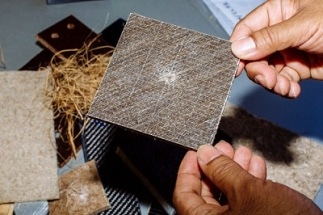Jan 21 2019
A team of researchers have developed a bio-composite material using date palm fiber biomass. The new material can be used to produce sustainable, lightweight and low-cost applications in the automotive and marine industries. (non-structural parts, such as car bumpers and door linings).
 New Lightweight Bio-composite Using Date Palm Fiber Biomass
New Lightweight Bio-composite Using Date Palm Fiber Biomass
The team involved researchers from:
- The University of Portsmouth
- The University of Cambridge
- INRA (Institut national de la recherche agronomique, a French public research institute dedicated to agricultural science)
Unlike synthetic composites reinforced by glass and carbon fibers, the date palm fiber polycaprolactone (PCL) bio-composite is completely:
- Biodegradable,
- Renewable,
- Sustainable and
- Recyclable
Bio-Composite with Enhanced Mechanical Properties
In a study, published in the journal Industrial Crops and Products, the researchers tested the mechanical properties of the bio-composite. They found that the date palm fiber PCL had increased tensile strength and achieved better low-velocity impact resistance than traditional man-made composites.
Dr Hom Dhakal, who leads the Advanced Materials and Manufacturing (AMM) Research Group at the University of Portsmouth and co-author of the study, said:
“Investigating the suitability of date palm fibers waste biomass as reinforcement in lightweight composite materials provides a tremendous opportunity of utilizing this material to develop low-cost, sustainable and lightweight biocomposites. The impact of this work would be extremely significant because these lightweight alternatives could help reduce the weight of vehicles, contributing to less fuel consumption and fewer CO2 emissions. The sustainable materials can be produced using less energy than glass and carbon fibers and are biodegradable, therefore easier to recycle.”
The study is one of the first to provide a comprehensive assessment of the improved mechanical properties of date palm fiber PCL bio-composites.
Waste Leaf Sheath Date Palm Fibers for Composite Reinforcement
Date palm fibers are one of the most available natural fibers in North Africa and the Middle East. Date palm trees produce a large quantity of agriculture waste, which is burned or land-filled, causing serious environmental pollution as well as the destruction of important soil micro-organisms. The part of the date palm tree which is often used as fibers is the sheath. The sheath is the part of the tree which surrounds the trunk of the plant. It is often torn lose when pruning the leaves.
“It’s a long journey,” said Dr Dhakal, “and we have to have patience and perseverance to make an impact. The challenge is getting consistent, reliable properties. It takes a long time to convince people to use a new class of materials, such as natural fiber reinforced composites for non-structural and structural applications.
“Meeting these challenges requires further research and innovation between academic institutions and industry.”
Dr Dhakal and his team have been working closely with industry to test the strength and viability of parts made from sustainable materials, such as date palm, flax, hemp and jute fibers. The AMM Research Group has been working in collaboration with researchers from institutions from around the world.
In the last 18 months, the group has published many high impact factor papers in journals including the Composites Science and Technology, Composites Part A and Composites Part B.
A recent collaborative study, published in the journal of Composite Part A: Applied Science and Manufacturing explored the potential of waste leaf sheath date palm fibers for composite reinforcement.